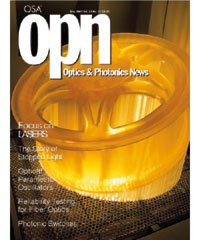
May 2002 Issue
- A Bright Spot
- Design of Large, MEMS-Based Photonic Switches
- Laser Fusion on a Tabletop
- Lasers for Solid Imaging
- OFC 2002 Review
- Reliability Methodologies for Fiber-Optic Components
- Secure Ultrafast Data Communication and Processing
- Spectroscopic Applications of Optical Parametric Oscillators
- The Story Behind "Stopped Light"
- Tracking Light Oscillations: Attosecond Spectroscopy Comes of Age
- Browse all Issues
Feature Articles
In the popular imagination, the laser is an apparition from the world of science fiction: a large piece of complex equipment, capped by a tube which shoots out a metal-vaporizing beam of bright red light. In reality, however, the laser that’s playing the liveliest role in an increasingly diverse market is a tiny chip of semiconductor material, the diode laser.
by Neil SavageDesign of Large, MEMS-Based Photonic Switches
Photonic switches are being deployed in optical telecommunications networks because the need for transmission bandwidth is outstripping the capacity of today’s optical-electrical-optical (OEO) switches.
by Roger Helkey, Scott Adams, John Bowers, Tim Davis, Olivier Jerphagnon, Volkan Kaman, Adrian Keating, Bin Liu, Chandra Pusarla, Daniel Xu, Shifu Yuan, and Xuezhe ZhengFor many years, laser-driven fusion has been the realm of large-scale laser science. A number of recent experiments have demonstrated that compact, femtosecond lasers of modest size can also drive nuclear fusion.
by Todd DitmireSolid imaging is a technology for fabricating 3D models from computer files. The article describes four commercial laser-based, solid-imaging technologies: stereolithography; laser sintering; laminated object manufacturing; and, laser-engineered net shaping.
by Jouni PartanenThe Optical Fiber Communication Conference & Exposition (OFC) weathered the burst of the telecommunications bubble much better than did many telecom companies. Exhibit sales were up, while attendance was down only slightly, to 33,000. The 13% drop from the record high registered at OFC 2001 was minor compared to job cuts in the 50% range at some telecom companies and to stocks that plunged over the course of the past year to a fraction of their peak values. The total of 1,204 paid exhibitors represented a healthy increase over last year's 970, although some empty booths were scattered around the sprawling Anaheim Convention Center, and some exhibiting companies appeared to have scaled down their displays.
by Jeff HechtReliability Methodologies for Fiber-Optic Components
One of the main features of the hard wired—and now fibered--telephone system has been its reliability. The reason for its reliability is a relatively simple one: the phone companies, starting with Bell Telephone, have set very high quality standards for themselves and their vendors. Adherence to high quality standards is even more important today, given society’s increasing dependence on telecommunications. Paradoxically, rapid technological advances in fiber-optic component technology and material science have made it difficult for reliability methodologies to properly quantify the reliability of components before they are placed in service. To get around this difficulty, in the choice of products and vendors, most suppliers and end-users rely heavily on qualification tests. In the case of immature technologies, however, qualification tests alone cannot guarantee reliability. True reliability programs must be used to follow up on them and verify their results.
by David R. MaackSecure Ultrafast Data Communication and Processing
Ultrafast data communication and processing systems that use ultrashort pulses allow data transfer rates faster than 1 Tbit/s without conversion to electronic signals. Spatiotemporal converters based on spectral holography are a key to the successful implementation of such systems. To send large amounts of data at ultrafast transfer rates, high-capacity data-storage systems that can operate at equally high rates of speed are also required. Holographic memo-ries can serve as an interface in ultrafast data communication, while optical encryption techniques can be used to ensure the security of the transmitted data.
by Osamu Matoba and Bahram JavidiSpectroscopic Applications of Optical Parametric Oscillators
This article focuses on the spectroscopic applications of optical parametric oscillators in the sensing of chemical processes, in industrial or environmental diagnostics, and in basic optical physics.
by Yabai He, Pu Wang, Richard T. White and Brian J. OrrThe Story Behind "Stopped Light"
Opaque media can be made transparent by use of quantum mechanical interference, enabling fascinating phenomena with potential applications in both classical and quantum information processing. In particular, recent laboratory demonstrations have shown that light pulses can be slowed down and effectively brought to a standstill in coherently prepared atomic ensembles, thereby reversibly transferring information between light and matter with potentially high efficiency.
by Ronald Walsworth, Susanne Yelin, and Mikhail LukinTracking Light Oscillations: Attosecond Spectroscopy Comes of Age
Can time-resolved spectroscopy be extended into the attosecond domain to capture the motion of electrons in atoms? This article reviews recent research providing the basic tools for the emerging field of attosecond atoic spectroscopy and addresses what remains to be done to make the technique applicable to a broad range of processes and atomic systems.
by Ferenc KrauszDepartments and Columns
The little-known security features of PDF documents can be used to discourage unauthorized modification.
The Story of a Sister Society in London
Seventeen years before the Optical Society of America was founded in Rochester, New York, a small group of optics buffs in Britain established the Optical Society (London). In the second edition of OPN’s new column, “The History of OSA,” John N. Howard describes the brief but inspiring history of the Optical Society (London), and its journal, Transactions.
Also in this Issue


![Manual probe system with needles for test of semiconductor on silicon wafer. [A. Morozov / Getty]](https://opnmedia.blob.core.windows.net/$web/opn/media/images/articles/2025/1125/departments/202511-cover-web.jpg?ext=.jpg)
![Researcher Clara Saraceno in the lab. [Image by Carsten Behler Photography]](https://opnmedia.blob.core.windows.net/$web/opn/media/images/articles/2025/1025/departments/202510-cover-web.jpg?ext=.jpg)
